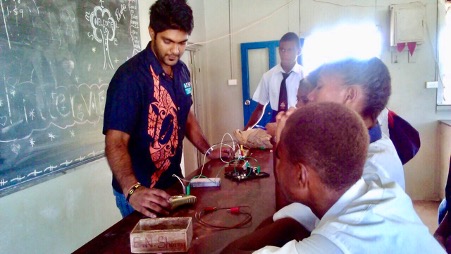PhD candidate Ashneel Chandra offers a brief outline of his recently published paper, co-authored with his Master’s degree advisor at The University of the South Pacific (USP), Professor Sushil Kumar, on their study of tropical cyclones TC Pam (Vanuatu 2015) and TC Winston (Fiji 2016).
![]()
In a new paper published in the American Meteorological Society’s Monthly Weather Review journal, Professor Sushil Kumar and I look at how the upper ocean responded to two devastating tropical cyclones (TCs) in the Southwest Pacific region: TC Pam in Vanuatu in March 2015, and TC Winston in Fiji in February 2016. These two TCs were selected for this study because of their significant intensity, both TCs attaining maximum strength just prior to making landfall.
I was a Teaching Assistant in Physics at USP when TC Winston struck Fiji. As part of USP’s outreach activities, a few of my colleagues and I visited schools that had to a large extent been devastated by the storm, to hold laboratory demonstrations for students.

Ashneel demonstrates to students how to read voltage and current using a multimeter as part of USP’s outreach activities to schools in Fiji devastated by TC Winston (2016).
The devastation caused by TC Winston placed Fiji in a State of Natural Disaster lasting over two months.

A school in northern Viti Levu, Fiji destroyed by TC Winston (2016)
![]()
Tropical cyclones are fueled by the heat energy stored in the upper ocean, and their strength depends largely on how much energy is transferred from the ocean to the atmosphere (this is called surface turbulent heat fluxes) at the ocean surface. Given the importance of heat energy in the upper ocean for the intensity of TCs, we used Argo floats in our study to measure upper ocean heat content (OHC) near the tracks of the two TCs. The Argo network is part of an international collaboration, with a global array of around 3900 floating cylindrical containers that measure temperature, salinity and pressure in the upper 2 kilometres of the ocean. Through our study, Professor Kumar and I found that there were systematic decreases in upper OHC and sea surface temperature after the passage of the TCs. We also found that surface turbulent heat fluxes played an important role in determining the intensity of the two storms. As TC Winston approached landfall there was a short burst of energy from the ocean to the atmosphere near landfall, which we suggest could have been the reason why this storm reached its maximum strength as it made landfall.
![]()
In this paper we identify significant gaps in the understanding of TC-ocean interactions in the Southwest Pacific region, some of which are due to a lack of high-resolution model and reanalysis data. The Southwest Pacific region remains a vastly interesting area for building up basic research and filling in prevailing knowledge gaps, not least the role of eddies (swirling structures in the ocean that can have either cold or warm water masses trapped in them) in contributing to the upper OHC near TCs in the region.

Ashneel Chandra is an affiliated researcher with the OceanStates project. He is currently a PhD candidate at the Geophysical Institute at the University of Bergen, where he is exploring tropical intraseasonal variability and continuing his research on ocean heat content.
Paper:
Chandra, A., and S. Kumar (2021), Sea Surface Temperature and Ocean Heat Content during Tropical Cyclones Pam (2015) and Winston (2016) in the Southwest Pacific Region, Monthly Weather Review, 149(4), 1173-1187. DOI: https://doi.org/10.1175/MWR-D-20-0025.1
*Front page thumbnail: TC Winston (2016). Photo credit: - Rapid Response - LANCE